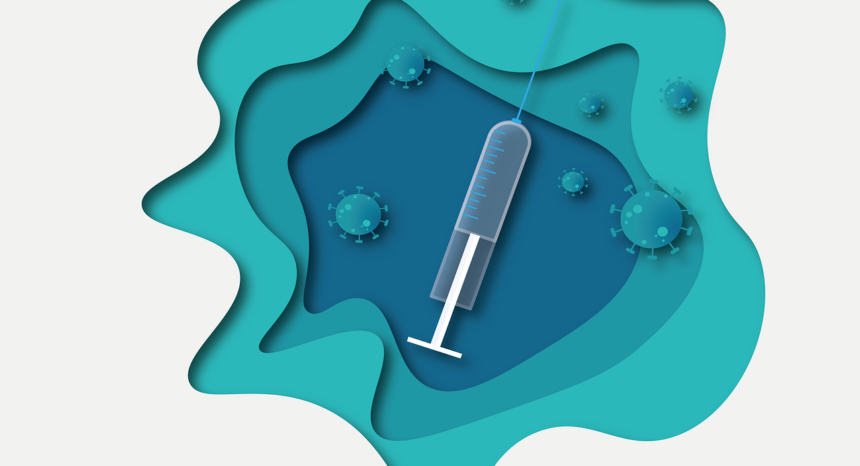by Naseem S. Miller, The Journalist’s Resource
February 9, 2021
Americans’ enthusiasm towards COVID-19 vaccines is growing. In January, more than four in ten adults said that they’ll definitely get the vaccine when it’s available to them for free, compared with 34% in December, according to a recent poll by the Kaiser Family Foundation.
Meanwhile, the percent of adults who said they wanted to “wait and see how it’s working” has dropped from 39% to 31% between December and January, the KFF poll shows. There has also been a slight drop in the percentage of adults who said they will only get the vaccine if required and those who said they will “definitely not get it.”
Still, although more Americans are embracing COVID-19 vaccines, the rollout has highlighted a segment of the population that didn’t receive much press coverage before the pandemic: vaccine-hesitant individuals. The World Health Organization defines vaccine hesitancy as “delay in acceptance or refusal of vaccines despite availability of vaccine services,” going on to explain that it is “influenced by factors such as complacency, convenience and confidence.”
In 2019, WHO listed vaccine hesitancy as one of the top 10 threats to global health, so it’s important for journalists to shed light on the issue and educate the public about it, but it’s also critical to distinguish people who are vaccine-hesitant from the so-called “anti-vaxxers” — a small but vocal group that actively advocates against vaccination.
“They’re separate from vaccine hesitant [people],” says science journalist Melinda Wenner Moyer, who has written about vaccines and vaccine hesitancy for the New York Times. She describes anti-vaxxers as “people who are doggedly sharing misinformation and trying to convince other people that vaccines aren’t safe. But most people are not that. Most people are somewhere along this spectrum of maybe just having one question that makes them a little bit uncomfortable until they have the question answered.”
Take the time to investigate vaccine hesitancy in your community and explain to readers its nuances.
“People who are vaccine-hesitant are a very heterogenous group,” says Maryn McKenna, veteran science journalist, author and senior fellow at Emory University’s Center for the Study of Human Health. “Try to make it clear to the reader or the viewer that vaccine hesitancy is not one thing, but it’s a spectrum. People have come to it with degrees of belief or disbelief for a variety of reasons.”
We asked several researchers and journalists how they think reporters should cover the topic of vaccine hesitancy. Here’s their advice distilled in six tips.
1. Find out why someone, or a segment of the community, is vaccine hesitant.
“Don’t assume that a community would be vaccine hesitant and don’t assume why a community would be vaccine-hesitant,” says Dr. Emily Harrison, a post-doctoral fellow at the Harvard T.H. Chan School of Public Health and Harvard History of Science Department and co-author of the essay “Vaccine Confidence in the Time of COVID-19,” published last April in the European Journal of Epidemiology. “Don’t go into a story assuming you know who is feeling what about the vaccine.”
2. Be compassionate and answer your audience’s questions about vaccines.
“It’s fully understandable that people have questions and concerns about the [COVID-19] vaccine, especially for a vaccine that’s new,” says Moyer. “We, as journalists, should be empathetic to that and be respectful.”
And let the public ask questions. You can collect the questions but putting out a call on your social media channels or on your news outlet’s website. Ask your local doctors or nurses what questions they’ve been getting from their patients and address those questions in your stories.
“If we don’t let the public ask questions, we don’t know what their questions are and we’re making assumptions,” says Dr. Cindy Prins, associate professor of epidemiology at the University of Florida.
Dr. Wen-Ying Sylvia Chou, program director of the Health Communication and Informatics Research Branch at the National Cancer Institute and a co-author of the study, “Considering Emotion in COVID-19 Vaccine Communication,” published in Health Communication in October, suggests having a well-respected community figure — an athlete, community activist or faith leader — to pose questions and concerns and have them answered by experts. For journalists, this could be an opportunity to create a virtual forum with local experts and leaders.
3. Don’t gloss over COVID-19 vaccine side effects. Do address what’s still unknown about vaccines.
“We should report on [vaccines] accurately and honestly,” says McKenna. “We should report on side effects and acknowledge them and communicate them to people precisely so any reports of side effects won’t get blown out of proportion.”
Explain that the side effects of COVID-19 vaccines — for the vast majority of people the side effects are minimal compared with getting very sick and being hospitalized with COVID, says Prins.
“It’s also important to say that just because [the COVID vaccine] is fast-tracked, it doesn’t mean that corners were cut,” says Chou, who helped write the National Institutes of Health’s COVID-19 vaccination communication guide for public health workers. “Yes, we’re still learning a lot and NIH has invested a lot in observing the long-term effects and side effects. But the benefits outweigh the risks. We need to be honest with describing all the things and tell people that this is the best solution we have right now.”
4. Balance the voices you include in your stories.
Your coverage of a vaccine allows the public to gauge how other people feel about it. If you interview only people who say they’re not getting vaccinated, inadvertently you’re making it appear that the majority of people in a certain group or community are hesitant to get the vaccine, even though polls show that’s not the case. Some 51% of Americans who haven’t received the COVID-19 vaccine say they definitely plan to get vaccinated, while an additional 26% say they probably would, according to a Jan. 27 report from the U.S. Census Bureau. Be sure to speak with those who have gotten the vaccine or are planning to get it.
“Bring in more than one perspective,” Prins recommends.
If your deadline allows, look for people who used to be hesitant and changed their minds and got vaccinated, she adds.
A recommendation from Harrison: Ask people who are getting vaccinated why they chose to get vaccinated and what gave them the confidence to get vaccinated.
5. Spend time in communities where most residents are racial or ethnic minorities to understand why vaccination rates tend to be lower.
Recent public opinion polls show that Black and Hispanic adults are warier of the vaccine than whites. The same trend is true for rural residents.
Researchers and journalists have examined the link between systemic racism and a relative lack of trust in the medical community. In a piece published in November on Wired, for example, McKenna delves into the history of medical racism that has led to vaccine hesitancy among some communities of color. And in a story published in February in the Los Angeles Times, reporter Kurtis Lee explains how the Tuskegee syphilis study has led to vaccine hesitancy in Black communities.
But vaccine hesitancy is not the sole cause of lower vaccination rates in some communities.
“Some might assume that lower vaccination rates are because people aren’t choosing to get vaccinated,” Harrison says. “But maybe it is in part problems of access. Maybe it’s a product of structural racism and who can actually get access to the vaccines. Statistics are an opportunity to ask questions.”
Journalists should also highlight the fact that many people in communities of color are willing to get vaccinated. For instance, while 22% of Black individuals surveyed by the U.S. Census Bureau in January said they probably won’t get the vaccine, about 64% said they will “definitely or “probably” get the vaccine.
Look for examples of people who are working hard to protect their families and communities from the pandemic, advises Dr. Reed Tuckson, co-convener of the Black Coalition Against COVID-19, a national group of doctors, public health experts and professionals whose aim is to bring information about COVID-19 and the vaccine to the Black communities and inspire trust.
“Tell the story of a younger person who is not eligible for the vaccine but took their grandmother to the site to get vaccinated because of the values of the Black family,” says Tuckson. “We should talk about this a lot more through the prism of the Black family and the relationship we have for survival. I think we need to be able to tell the story of survival.”
He also advises featuring local activists in stories.
“Find someone who is a Black Lives Matter activist, who says, ‘Black lives matter,’ and, therefore, they want to make sure that [their community] gets access to the vaccine,” Tuckson says. “You really should be telling more stories about those who are fighting for equitable access at the local level.”
6. Talk to researchers and academics who study vaccine hesitancy.
Science journalist Tara Haelle, who has written extensively about covering vaccines, features a list of peer-reviewed studies on vaccine hesitancy in a blog post on the Association for Health Care Journalists website. Reach out to the authors of the studies for comment and advice.
“And make sure you talk to multiple people so that you get different perspectives and then potentially look for the consensus perspective,” says Prins.
Ask experts to suggest other sources, including those who might have a different perspective. And double-check your work.
“It’s really incumbent on us as much as possible to check our stuff with experts,” says McKenna. “We should be seeking out people who can be our informal fact-checkers and can tell us that something is right or wrong or that we’ve misinterpreted a number, so that we can be as accurate as possible.”
Looking for more tip sheets on covering vaccines?
Need an expert?
This article first appeared on The Journalist’s Resource and is republished here under a Creative Commons license.
SOURCE: Naseem S. Miller
VIA: The Journalist’s Resource
MAIN IMAGE SOURCE: Alexandra_Koch from Pixabay









